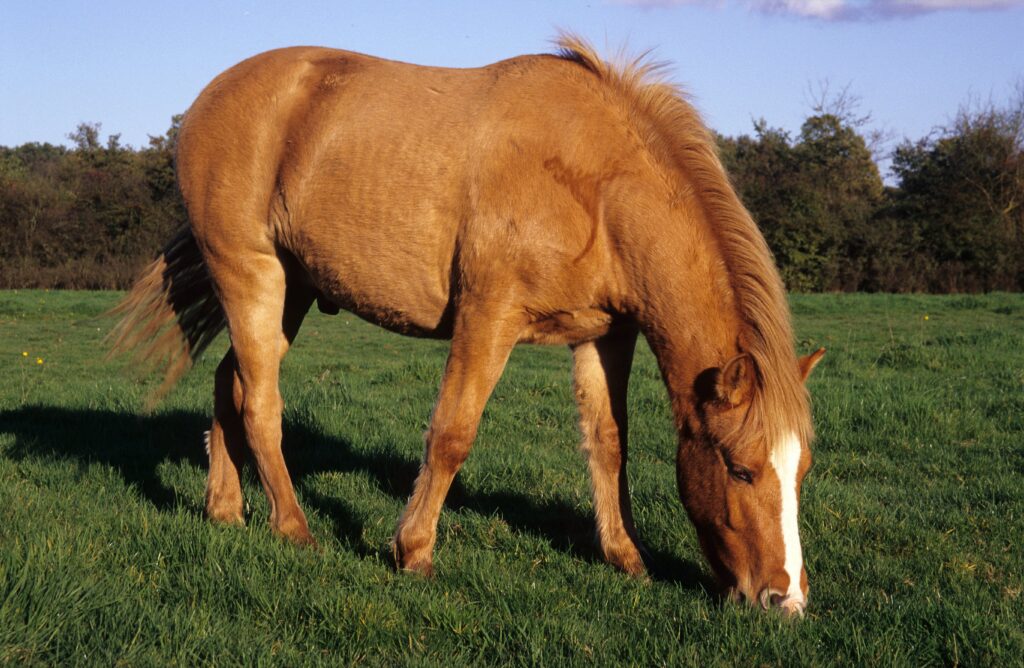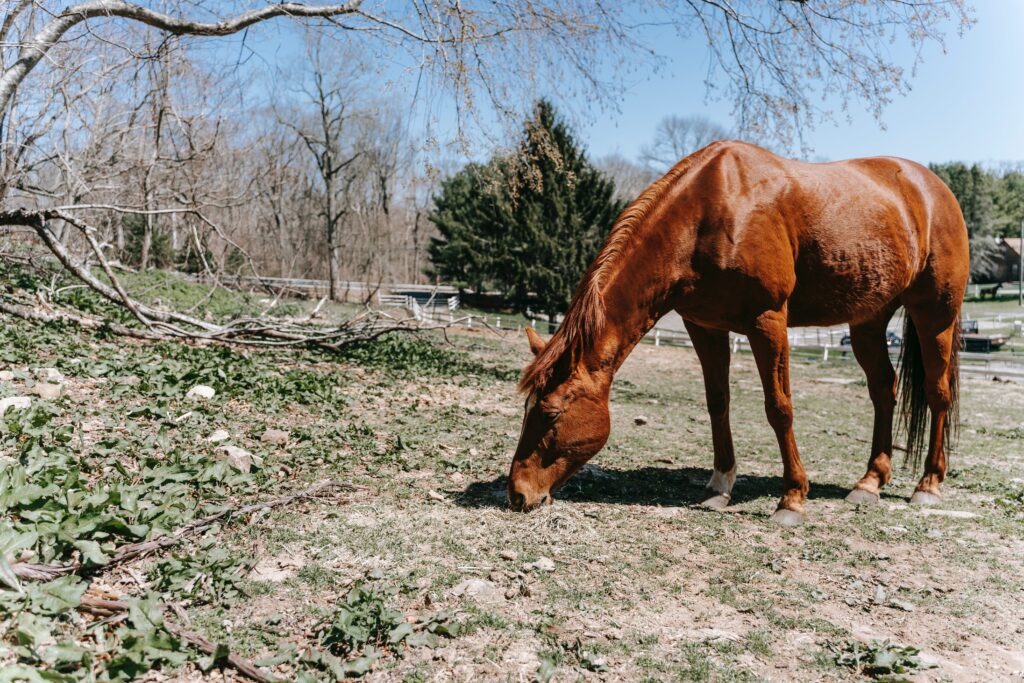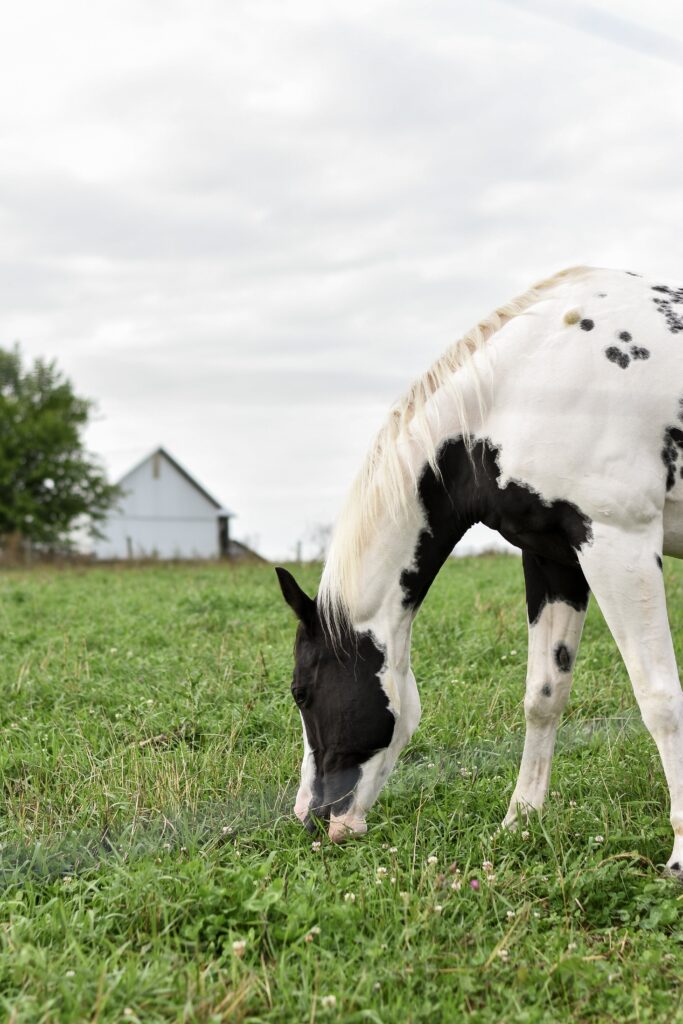Implementing a horse pasture rotation system is one of the best things you can do for your horses and land. When you rotate horses between paddocks or pastures, you give the grass time to regrow. Doing this prevents overgrazing, and has health benefits for both horses and grazing pastures.
This article will explore why you should create a rotational grazing system. Here’s how to successfully create a system on your property that doesn’t just help you pastures survive, but thrive!

What is Horse Pasture Rotation?
Horse pasture rotation is the practice of moving horses between multiple paddocks to prevent overuse of any one pasture. Typically, you should rotate your horses on and off every 2 weeks to 6 months. However, this grazing management technique depends on climate, number of horses, acreage and other factors.
Why Should You Rotate Your Pastures?
The goals of pasture rotation for horses are:
- Allow paddocks time to rest and regrow grazable vegetation
- Prevent horses from eating plant roots along with grass blades
- Avoid weed takeover and soil erosion in heavily trafficked areas
- Interrupt parasite life cycles in each grazed section
- Improve nutrition as horses graze higher quality grass
If pastures are overgrazed without a rest period, you risk long term damage. Potential issues that may occur include an increased risk of illness, infection and even toxicity issues in horses. Rotational grazing optimizes pasture health.

How Often Should You Rotate Horse Pastures?
Determining optimal pasture rotation frequency involves:
- Number of horses
- Size of paddocks
- Forage growth rates in your region
- Is the grass irrigated or not
As a general rule of thumb, move your horses to a new pasture when they’ve grazed the grass under two inches. Then, let the pasture grow back to six inches.
If you want to rotate pastures, be prepared to commit to letting your pastures sit empty for at least one to two months.
Split larger pastures to create smaller paddocks for rotation. Higher horse density per acre means rotating them more often. You’ll need to adjust timing as needed based on seasonal fluctuations, drought and observation of pasture recovery.
Planning an Effective Horse Pasture Rotation System
Executing smooth paddock-to-paddock rotational grazing requires planning the specifics including:
- Pastures sectioned off for rotation
- Order horses will rotate through pastures
- Dates when horses will be moved from one area to the next
- Ongoing land maintenance between rotations
Mapping Out Your Horse Pasture Rotation
Start by drawing a layout of your property. You need to include fencing, paddock divisions, shelters, water access points etc. Identify areas best suited for rotational grazing. See which fences need repairs. Plan the location of mobile components like water troughs before defining your horses’ rotation schedule.
Schedule Sequence & Timing for Horse Movement
When planning a rotation schedule for horses in different pastures, consider:
- How many horses are grazing. More horses require more frequent rotation to prevent overgrazing.
- The total acreage of grazing land and size of each pasture. Smaller pastures have less grass so horses need to move off them more often to let it regrow.
- The ability of the grass in those pastures to regrow to a livestock-grazable height. This could be roughly two to eight weeks.
- Enough time to allow each pasture area to fully regrow its grass before horses return to graze it again. If bare ground appears, you’ll need to let it recover for longer.
Use these four factors to create a rotation schedule that avoids horses staying too long on any one pasture. Don’t be afraid to adjust this schedule as needed throughout grazing seasons. Adapt your schedule seasonally, although you may need to account for variations in pasture productivity.
Overseeing Recovery Periods Between Rotations
While each paddock is in resting phase without horses, muck/reseed if needed to bolster forage. Address pest plants, erosion, manure piles or wet spots. Confirm fences remain secure before horses return for grazing. Evaluate results before fine tuning duration and order of horse rotation in subsequent grazing cycles.

Best Practices for Your Horse Pastures
Paddock layout and terrain features play an important role in efficient forage use and land management over time. Here are a few tips:
Work With Your Horses’ Grazing Pattern, Not Against It
Horses tend to graze in circular movements out from water, shelter and supplemental feed sources. If you have long, narrow paddocks, your horses may not graze in remote areas, and they’ll compact the soil where they do graze. Rectangular or square configurations may be your best bet.
Avoid Irregular Shaped Paddocks
Weirdly shaped paddocks with rambling borders have less uniform regrowth and prove more difficult to mow using tractor equipment. Smoother perimeter lines, such as with rectangular paddocks, simplify maintenance activities needed between grazing cycles.
Balance Forage Productivity Between Paddocks
Ideally soils, drainage and other productivity factors will be consistent across paddocks. If they are not, balance rotation time allocated to each so that total forage consumed remains fairly equal. The key is to avoid restricted grazing access due to one paddock being extremely deficient compared to the others. Assess each area’s weaknesses and strengths and divide grazing pressure accordingly.
Reduce Erosion Risk
To reduce soil erosion within your paddocks, avoid aligning long paddocks directly up and down steep slopes. Heavy rain can then transform the pasture into a drainage channel, rapidly eroding soils.
Executing Smooth Horse Pasture Rotations
When transition day comes for rotating horses on/off a given pasture area:
- Start by double checking fences, gates, and water sources
- Shift portable temporary fencing, water buckets/automatic waters safely
- Ensure horses have left no fallen fruit, debris in new area
- Check horses’ hooves and body condition; address any issues
- Work as a herd through corridor gates without escapees
Ideally you should provide your horses free-choice mineral blocks in each paddock during its active grazing period. Keep an eye on the horses for signs of illness since risk varies by paddock based on prior manure.
Solutions for Common Horse Pasture Rotation Hurdles
What if your property has limited paddocks or uneven terrain? Here are some troubleshooting tips:
Subdividing Large Pastures
If your property only has one or two large pastures, consider adding fencing to subdivide them into smaller paddocks.
This instantly increases your rotation options without needing additional land. A temporary electric fence can create temporary partitions. Just be sure to clearly mark boundaries for your horses.
Clearing Land to Add Paddocks
Consider any overgrown areas that could be cleared and maintained as productive pasture. Safely remove brush, trees or weeds then establish a productive forage mix suitable for horses. This opens up new paddock space to augment your rotation system.
Dry Lots for Short-Term Use
Designate a section of your property as a dry lot where horses can stay when transitioning between rotations. This double duty area spares other pastures extra impact when moving between grazing paddocks. Maintain with proper manure management.
Transport Horses Between Leased Grazing Lands
If you own minimal land, consider leasing additional pasture space elsewhere. Transporting horses via safe trailers allows accessing rented pastures miles apart. Coordinate leases so acreage is available on a rotating basis to prevent overgrazing any one rented site. Requires planning but maximizes land usage.
Rotational Pasture Grazing for Horses Doesn’t Have to Be Difficult
At the end of the day, the key is to avoid full-time continuous grazing on any one horse pasture. Get creative with pasture boundaries, scheduling and close observations of forage/land recovery. It doesn’t have to be hard: grab a pencil and paper to draw a map of your horse farms and create a timeline. Once you have a system, hang it up in your barn and create calendar notifications.
The payoffs of horse pasture management and rotation – improving nutrition, health and decreasing veterinary expense – make logistical efforts worthwhile.
Additional Pasture Management Resources
Equine Pasture Management: “A Year-Round Approach” from Rutgers
Rotational Grazing on Horse Farms from University of Kentucky
